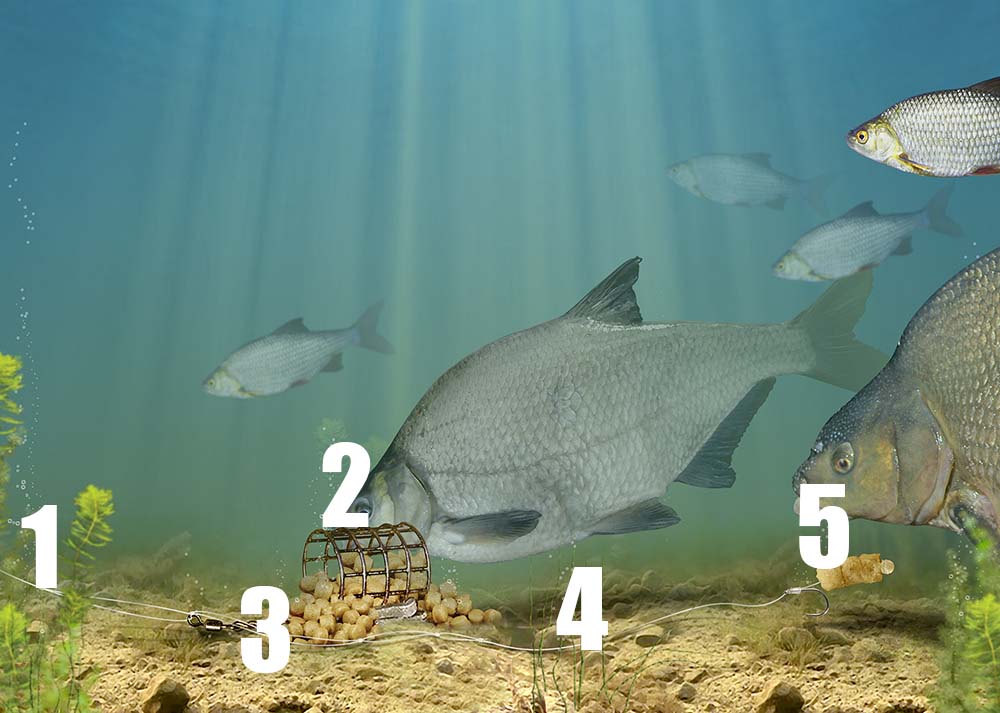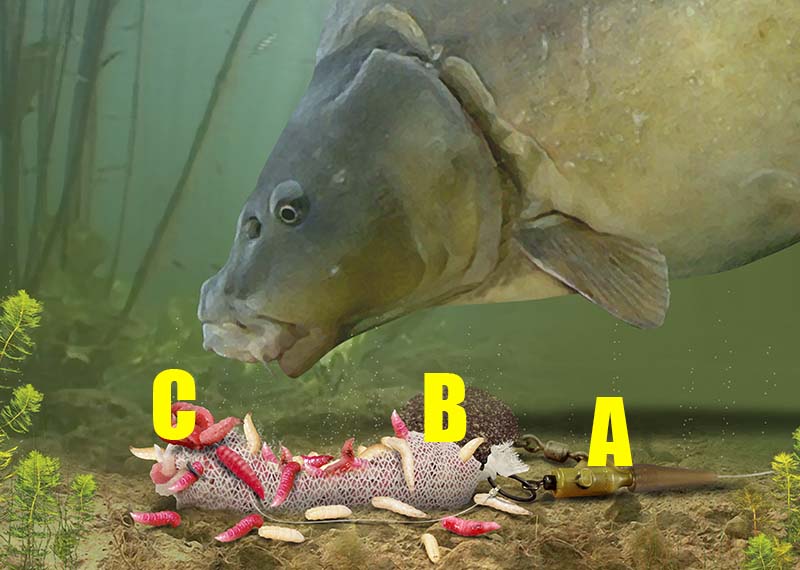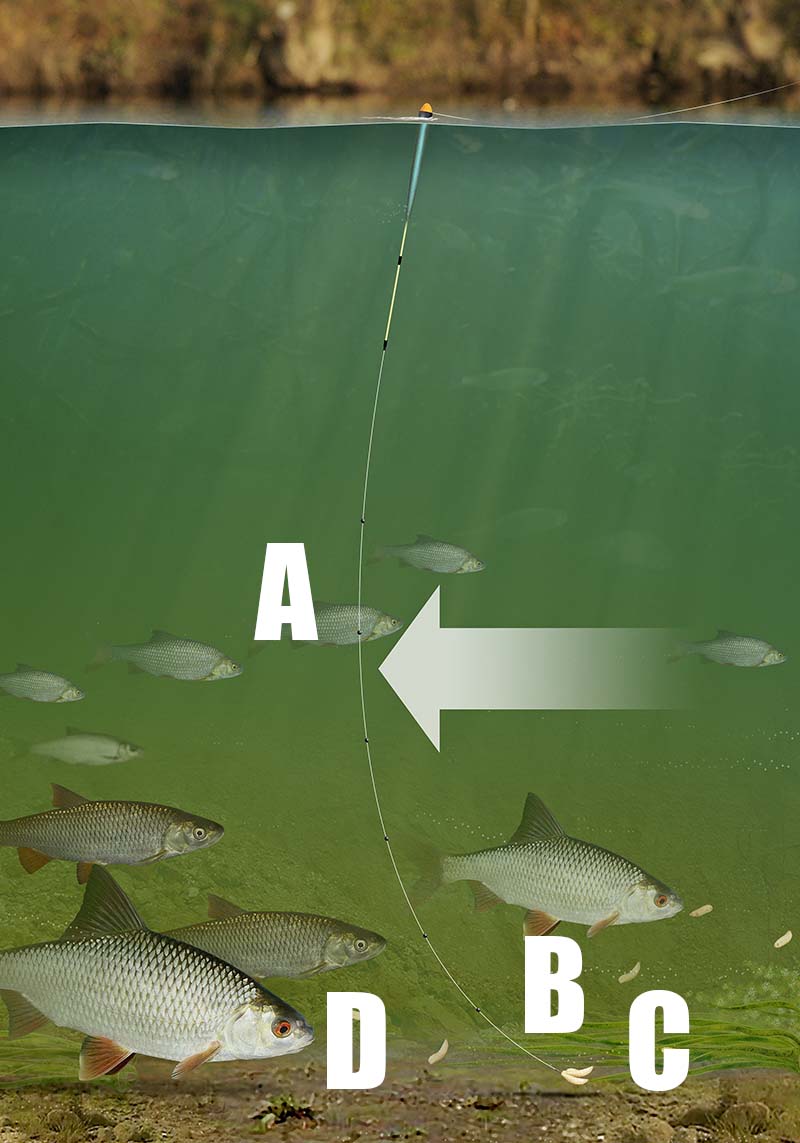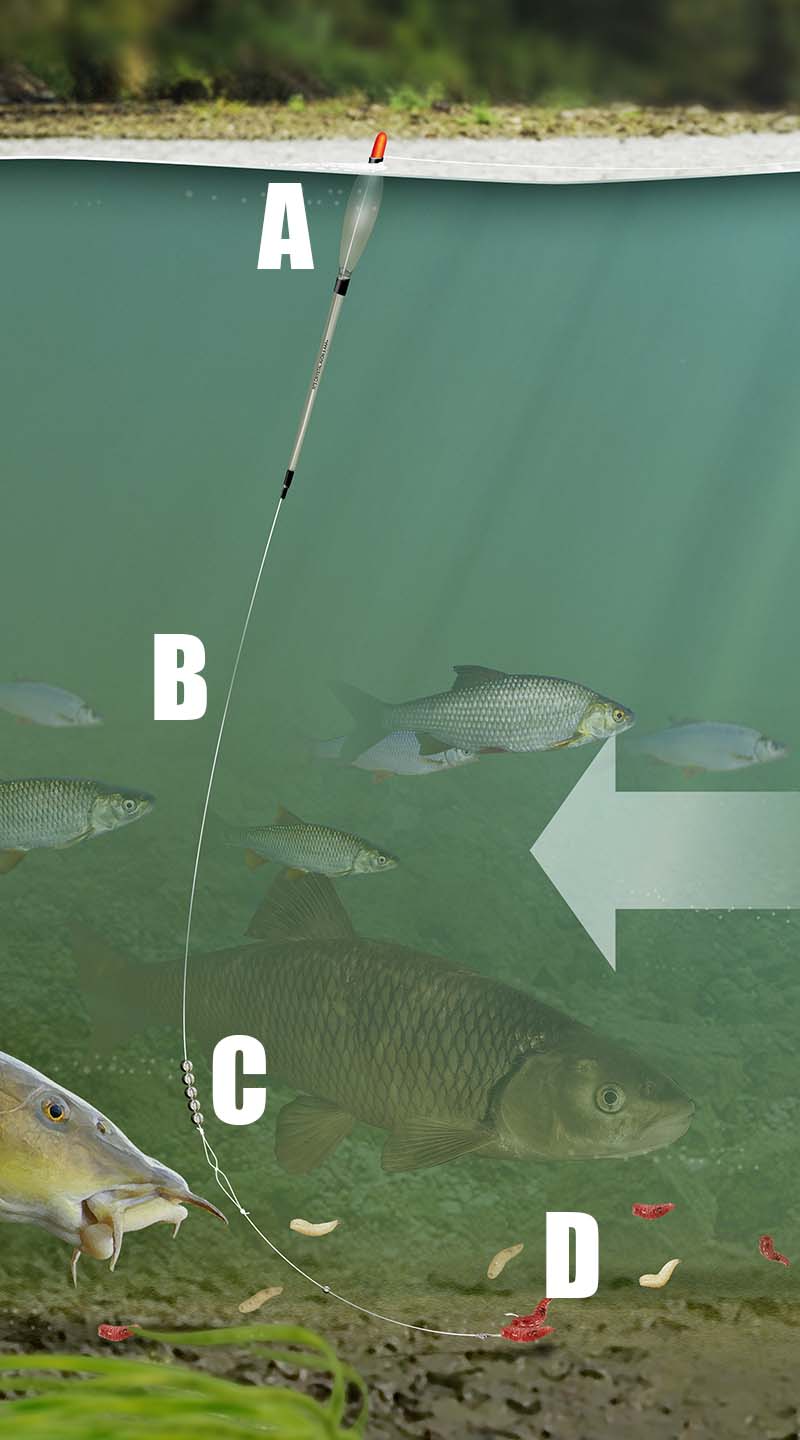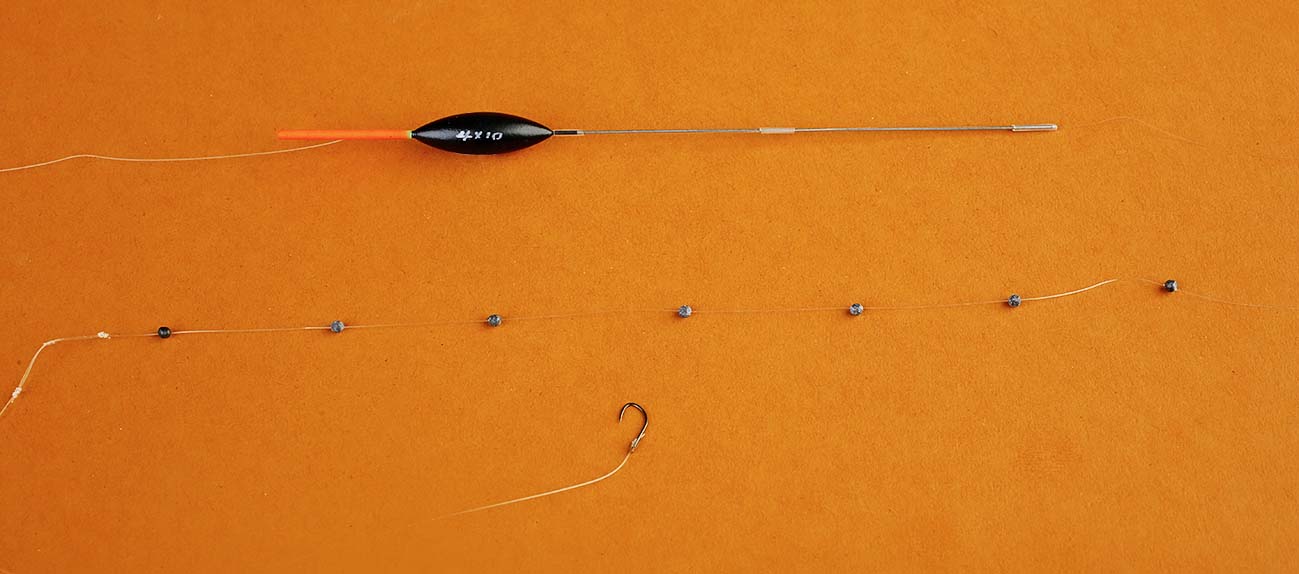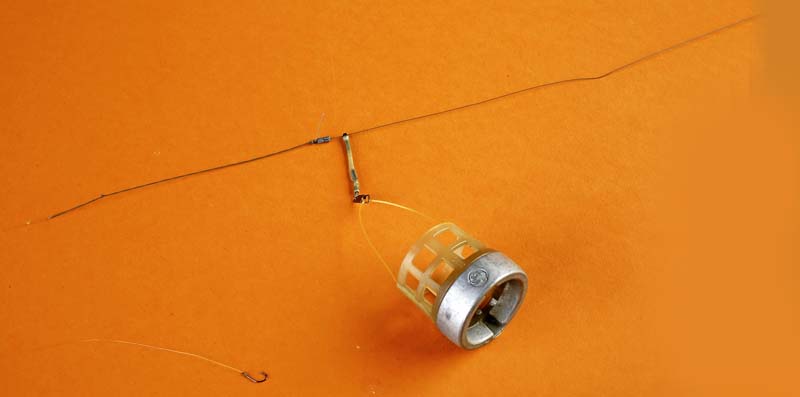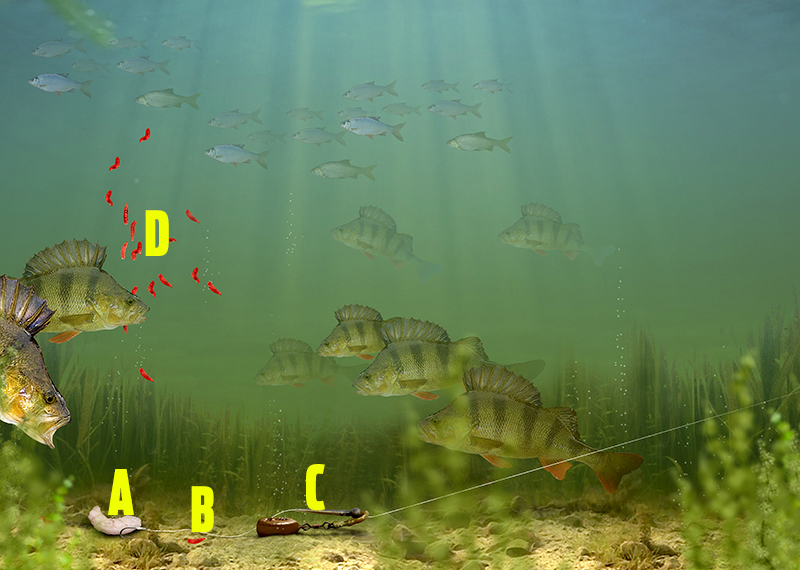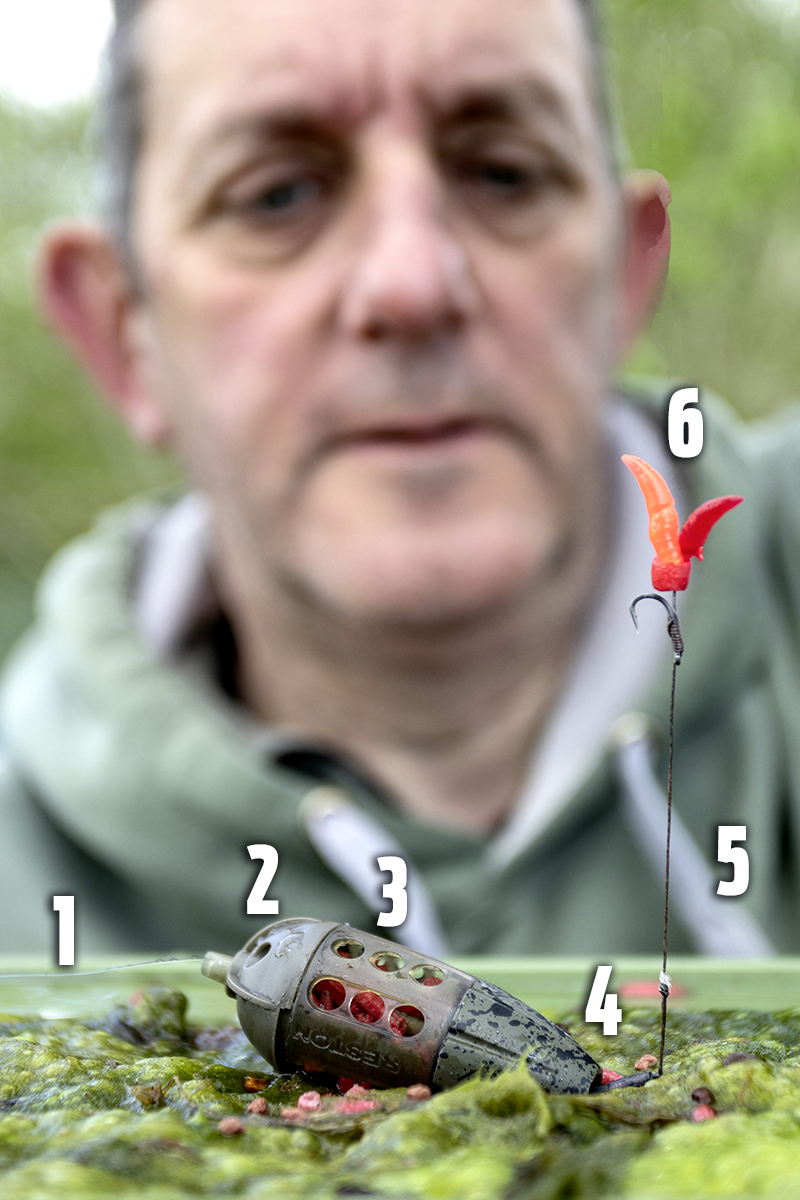Bream Fishing Rigs | Feeder rig for bream
Commercial fisheries are about so much more than carp these days, with bream and skimmers becoming an increasingly common target for match and pleasure anglers alike.
The pole is a great way to catch them if conditions and your swim allow, but the feeder is still hard to beat for keeping a few fish going into the net.
However, you’ll not need the long distance stepped-up kit of the summer months on big lakes and reservoirs to catch them. Instead, a more refined scaled-back rig will get the job done, along with feeds and baits that give a definite nod to the commercial carp scene.
On venues such as Meadowlands Fishery in the West Midlands the skimmers happily live alongside the carp and can fill in the blanks otherwise spent waiting for a carp to find the bait. Soo follow our advice here and add some bream to your match catch…
1) Running or fixed?
Fishery rules may dictate whether or not you can use a fixed rig such as the one shown here. If both are allowed, the choice is yours. A running rig will tangle less and sees the feeder run directly on the mainline, stopped just above the hooklength. A fixed rig can result in a better bite and more bream hooked, and involves trapping the feeder inside a 6ins-8ins loop in the mainline. The feeder can still run, but will stop when the rig is pulled a certain distance by a fish picking the bait up. In this instance, it’s possible that the bream will hook itself.
2) Cage feeder
A cage is better than a plastic open-end feeder. It is made of metal and so is heavier and can be cast further with more accuracy. The contents will empty quicker too, useful on shallow lakes. In deeper swims you’ll be better off with a plastic open-end with fewer holes for the feed to get out. Pick a small model to start, as you don’t want to put in lots of bait, and go for a weight that allows you to comfortably reach the distance you want to fish at.
3) Looped boom
Whether you go for a fixed or running rig, to cut down on tangles with a fixed rig, tie several small loops in the mainline immediately below the loop that the feeder sits in. This creates a stiff ‘boom’.
4) Hooklengths
A 50cm-long hooklength is good for starters. If you find that you are getting bites but not connecting with them, shorten the link by 10cm at a time until you hook fish. Going longer can work on harder days or if you think that the fish are sitting just off bottom and watching the bait fall. A tell-tale sign of this is a sharp tap on the quivertip just as the feeder settles.
5) Top baits
Ringing the changes on the bait front is another important aspect to master. Single or double red maggot makes a good starting bait, but a redworm can work wonders on tricky days. Dead maggots are equally good, especially on silty waters, and a bait that can work on commercials is two or three small, hair-rigged expander pellets.
Carp fishing rigs | The pellet cone rig for carp
The cold snap has well and truly put the mockers on fishing.
Thoughts of mild weather are a distant memory – but the fish still have to feed and, with a slight change in tactics, it’s still possible to get a few bites from commercial fishery carp.
Whereas the feeder would have ruled in warmer weather, when temperatures tumble and water clears, the pellet cone takes over.
This simple approach is basically bomb fishing but with a cone of compressed micro pellets sat just above the hookbait.
Your bait is placed right in amid the feed and you have the option to feed varying amounts through changing cone size or, indeed, nothing at all by dispensing entirely with the cone.
How to make a pellet cone
• Fill your chosen cone with prepared micro pellets.
• Push a baiting needle through the cone and attach the hooklink.
• Slide the cone down the line until it rests just above the hookbait.
• Ease the cone off and attach the hooklink to your mainline.
How to tie the pellet cone rig.
Bombs
The size of lead you use will be dictated by how far you need to cast, but also the size of the cone. A big cone will be a job to cast 50 yards with a 0.5oz lead. Put simply, if the lead and cone somersault on the cast then the weight is too small. As a guide, a 1oz lead is about right for general commercial fisheries but on big reservoirs, you may want to think about upping this to 2oz.
Hooklink length
Eight inches to a foot is about right, ensuring that the lead is kept away from the cone and hookbait to avoid any chance of spooking fish in clear water. This is also long enough to eliminate the chance of tangles on the cast as the cone wraps around the lead, as can happen with a shorter link.
Which pellets?
Micro pellets are the only size you’ll manage to squeeze into a cone, but they’ll need preparing first. Soaking them in water for a few minutes and then draining them off and leaving them to dry will do the job but give this process time, allowing the water to fully penetrate and completely soften each pellet. For long casts you can add a pellet binding powder to them if you wish, although this may slow down how quickly the cone breaks up in the water.
Pellet cone sizes
Commonly, there are three cone sizes on the market. Just as with feeder fishing, which one you pick will govern how many pellets you feed. The smallest cone is ideal for cold, hard days, while the biggest size is the one to pick for big carp on mild days when the fish may be a little hungrier, or if you plan on leaving the rig out for a long time.
Carp Fishing Rigs | How to tie the mag aligner rig
Want to catch carp in the winter? Then this is the rig you’re going to need. With the carp having a reduced metabolism and appetite, now is not the time to pile in mountains of boilies, yet a carefully presented pile of ‘wrigglers’ can soon get your bobbins dancing.
As far as maggot rigs go, the mag aligner really does takes some beating. By using a large PVA mesh bag of maggots tied to a big rig ring by the lead, the mag aligner is virtually tangle-proof on the cast.
What’s more, using a fake maggot as a line aligner over the hook makes the rig extremely hard for the carp to deal with, leading to reel-churning runs in even the coldest weather
A) Terminal set-up
Use a lead clip rig or a helicopter set-up.
B) Large rig ring
Leave a tag end on the PVA bag knot and tie it to a large rig ring.
C) Anchor point
Nick the hook into the bag before casting to help prevent tangles.
How to make a Mag Aligner
1) Pierce the underside of the fat end of a fake maggot with a baiting needle and run it along the base until it exits the pointed end.
2) Tie a hook on to the end of your hooklink using a grinner knot. Grab the hooklink with the baiting needle and thread on the fake maggot.
3) When complete it should look like this. The hooklink should exit the maggot from the underside. This helps the hook to flip over.
Roach Fishing Rig | Stick float roach rig
Rain means added flow on our rivers and this is when the stick float comes to the fore. It’s capable of running a long way down the swim and searching a lot of water.
The waggler rarely works in these high water conditions, which means a top and bottom-style float is a must.
Highly buoyant and easy to see when trotted a long way down the swim, the stick also offers great control and stability when riding uneven water. It lets you slow the run down to half the pace of the river, or even make the tackle stand stock still.
A) Shotting
Sticks can be shotted with a bulk to keep the bait on the bottom in any strength of flow but in autumn when the fish will still be reasonably active, using a strung-out pattern (known as shirt button style) lets the hookbait behave very naturally in the swim.
Checking the float to a standstill will see the bait rise up off the deck slightly, which can often induce a bite.
B) Depth
You can fish overdepth with the stick float in slower water but to get the best out of the float, set it just touching bottom. This will stop the float from being dragged under in strong currents.
C) Bait
Go big! Double maggot or caster is a meal few roach will be able to resist, or you can take a leaf out of the specimen hunting book and use a piece of breadflake in clear water for a real specimen.
D) Feed
Regular feeding is essential to ensure a steady stream of bait is going down the peg. This will not only keep fish in the swim but also draw any sat well downstream – these will move upriver to investigate the free flow of food. Maggots, casters and hemp are all good choices, fed every cast.
Barbel Fishing Rig | Big top and bottom float rig
Targeting fast and shallow swims flanked by willow trees for big chub and barbel is adrenaline-pumping stuff.
You’ll have a real battle on your hands once a fish is hooked – and the tactic needs a very different top and bottom float set-up to a traditional stick float rig.
Owing to the pace, you need to fish a heavy Avon-style float taking several AAA shot to not only give you great control of the rig but to also get the bait down to the bottom quickly.
Lines and hooks also need to be strong, as your tackle will take a lot of punishment over the course of a five-hour session. It’s not really for the faint-hearted, but the results can be truly satisfying!
A) Float size
With the river running at full pace, your float won’t be in the swim for that long because it will soon trot out of the peg.
To get the bait to the bottom at the head of the swim, pick a big top and bottom float taking 4-5 AAA shot. This will let the float cock immediately and begin fishing because a bite can often come right at the head of the swim.
B) Pile on the pressure
When a fish is hooked, don’t stand back and admire the curve in the rod – the fish will do you in a snag! Instead, wind right down and pull hard on the fish to subdue that first run and put you in charge of the fight.
A through-actioned rod will help here, absorbing the lunges and runs without the danger of a snapped hooklink.
C) Bulk shot
In shallow swims you’ll not get bites on the drop and the aim is to get the bait down to the bottom in seconds.
This means a very simple and positive shotting pattern made up of all the float’s weight grouped into a bulk just above the hooklink. Typically this will be made up of large BB or AAA shot.
D) Proper tackle
Not only are the chub and barbel you’re aiming for of a decent size, but the riverbed may be uneven, with lots of rocks.
Naturally, a hooked fish will do its best to cut you off by rubbing the line against these snags.
It makes sense then, to use heavy tackle with a hooklink of around 0.16mm or 0.18mm and a strong size 14 or 12 hook for fishing big baits.
Five amazing fishing rigs
Here are five amazing fishing rigs to help you catch more next time you are on the bank. Whether you fish with a pole or a rod these rig will keep you catching all day long and give you the best chance of perfectly presenting your bait. So here are five of the best fishing rigs with Steve Ringer.
Carp Ape
The KC Carpa Ape is a versatile float pattern that I use for lots of different options, ranging from shallow work to mud-line fishing against an island.
In autumn it comes into its own for fishing across in 18ins to 3ft of water on a snake lake.
Mainline: 0.15mm Guru N-Gauge
to a 4ins hooklength of 0.14mm Pure Fluorocarbon, which I really like at this time of year when the colour starts to drop out of venues – I’m convinced it gets me those extra bites.
Hook: Size 16 or 18 Guru F1 Pellet. These are perfect for pellets, corn and even maggots.
Shotting: Normally a tightly strung bulk of No10 shot. However, if the water is very clear I will string these out more to achieve a slower fall of the hookbait. Mix it up to find out what works best on the day.
Mick Wilkinson F1 Slim
I designed this float with Mick as I wanted a slim-bodied wire stemmed float with a relatively short bristle that sits quickly when lifting and dropping the rig.
Mainline: 0.13mm Guru N-Gauge to a 4ins hooklength of 0.10mm Pure Fluorocarbon. Fluoro gives me an edge once the water starts to clear.
Hook: Size 18 Guru F1 Pellet for maggot and pellet work. This fine-wire hook is spot on for F1 fishing and is easily s’ ’carp too.
Shotting: This depends on whether I am maggot or pellet fishing. For maggots I’ll always opt for a loosely strung bulk of No11 shot and for pellets a tightly strung bulk. My theory has always been that shy-biting F1s follow maggots down before sucking them in, so a slowly-falling hookbait is important.
This is backed up by the fact that when maggot fishing most bites come just as the float settles.
Pellets seem very different. I always feel a more positive shotting pattern works better.
Carpa Perfect/Gloucester
My favourite pattern for deep-water silver fish work, I use this for all my Irish work as well as winter pellet fishing for skimmers.
This float features a wire stem so is super-stable, plus it has a thick bristle, meaning it’s easily visible in even the poorest of conditions.
Float size depends on depth and conditions. As a guide, for deep-water skimmer fishing in fair conditions I will opt for 1.25g.
Mainline: 0.15mm Guru N-Gauge – quite heavy, but this helps to minimise tangles when shipping in and out at speed. Hooklength is 6ins of 0.12mm Pure Fluorocarbon. There is always the chance of a rogue carp, and this gives me a good chance of landing it.
Hook: Size 16 Guru F1 Pellet.
Shotting: Slightly different to the norm. In deep water I like to fish with positive droppers, so I use double No9s with the first pair 7ins from the hook and the next two 7ins above this. Then, a further 7ins-8ins further up, I have my olivette and shot.
Something I do on all my heavy rigs is fix a few small half-styls a few inches above my olivette. These allow me to fine tune the bristle of the float during the session.
Mick Wilkinson steady
If I had to pick one float to do the lot on commercials, then this would be it! There isn’t a single bait that I wouldn’t fish with it. Pellets, corn, meat and even maggots, the Steady is perfect for them all. It’s also a float I will use on both short and long pole where carp are concerned.
I’m a firm believer that light floats produce more bites once the water starts to clear. I’ll often use a 4x10 float in depths of 4ft-6ft, to give that all-important slow- falling hookbait that appears as natural as possible.
Mainline: For carp it’s 0.17mm Guru N-Gauge to a 6ins hooklength of 0.15mm in the same material.
Hook: Size 16 super LWG which
covers me for both meat and corn hookbaits, as well as maggots and pellets.
Shotting: Loosely strung bulk of No10s, with the bottom shot 6ins from the hook and the rest of the droppers spaced at 1.5ins-2ins intervals above this.
The idea is to get a slow and even fall of the hookbait – when carp fishing in the colder months most bites tend to come just as the float settles, indicating that the carp has spotted the hookbait and followed it down.
Running Feeder Rig
One question I get asked more than any other is how to tie my running feeder rig, which I now feel I have pretty much spot on in terms of knowing I’m always fishing tangle-free.
This is the rig I use for everything from the World Feeder Championships to Ireland. It can be used with or without a shockleader, and whether I use one or not really depends on the distance at which I am fishing.
1: Thread a link on to the line. The one in the picture is a prototype Guru link which is based on my own version. You’ll notice it’s covered in shrink tube, which eliminates any tangle-causing sharp edges or tags. I prefer a short link of 1.5ins.
2: Fix two No8 Stotz on the line.
3: Tie a 3ins twizzled loop below the Stotz.
4: Slide the Stotz down to the knot at the top of the 3ins twisted loop.
5: Tie a 1ins loop in the end of the 3ins twisted loop.
6: Attach your hooklength to this loop, loop-to-loop style.
Perch Fishing Rig | Prawn rig for big perch
Now that the weather is cooling down, these popular predators are starting to feed in earnest, and the good news is, you can catch them using the same methods from almost every fishery in the land!
There are many ways of catching perch, but for this week’s Catch 22 Challenge we thought we’d put you on to a fantastic way of putting a specimen in your net.
Prawns are a wonderful bait for perch! Their fishy aroma and soft texture make them irresistible and a legered prawn, cast into the right area on a river, lake or canal, will soon be taken. Both raw and cooked prawns work, and they take colour and flavour really well too. Try dyeing them red!
Perch love features, whatever these might be, from dumped shopping trolleys on city-centre canals to marginal reeds on commercials. Other favoured areas are lock cuttings, weir pool slacks, close to fishing platforms, beneath overhanging trees and around aerators.
Of course, it helps to fish where there are healthy stocks of small silver fish to eat. Find both features and prey fish, and a big perch or two, will certainly not be far away. Even relatively featureless areas will hold perch if they contain lots of silvers.
Quite wary of any resistance, big perch should be targeted with a sensitive set-up. Try fishing with a fine quivertip, or with the rod pointing at the leger and the reel’s bail-arm open with a drop-off indicator fitted. Here is the rig to catch them using prawns...
A) Hook and hookbait
Hair-rigging is best, which also allows you to use a smaller, less obtrusive hook. Go for a size 10 or 8.
B) Hooklink
Use a hooklink of around 18ins-2ft of 6lb mono. This will keep the bait far enough away from the lead not not arouse any suspicions from a big, wary predator.
C) Free-running lead
Use a 1oz leger weight heavy enough not to move during the run – changing the feel of resistance to the taking fish – but light enough to not cause too much disturbance when cast. The lead is free-running to reduce the chance of the perch feeling it and dropping the bait.
D) Feeding
If you’re fishing within catapult range for perch, use red maggots, which will attract small prey fish. For longer distances, chunks of prawns are ideal.
Roach Fishing Rig | River waggler rig
Few tactics are more fun than running a waggler down a steady stretch of your local river and putting together a mixed bag of chub, roach and other silver fish.
When the conditions are right this is a very successful style of angling, with fish often being caught on the drop as well as when the hookbait is tripping along the riverbed.
Many anglers struggle with this tactic, for two simple reasons. First, they attempt to fish like this when the wind is blowing downstream. This will make presentation very difficult, as the wind will constantly pull the float off line. The type of waggler and its shotting pattern have to be correct, too, to avoid tangles and to present a slow-sinking bait.
Use a waggler with a thick, buoyant tip that resists being dragged off line or under when the hookbait catches the bottom.
Spread the shot evenly to ensure a constant sinking rate and to avoid tangles.
If you follow these simple steps your set-up will work effectively, giving you some fantastic sport.
1) Float adaptor
A float adapter enables the float to be changed quickly and offers little resistance on the strike.
2) Even speed of fall
No6 shot set at 2ft intervals down the line help the hookbait to fall through the water at a natural speed.
3) Maggot hookbait
Big chub and smaller silver fish will both readily take a double red maggot hookbait on a size 18 hook
How to tie a river waggler rig
1) A float adaptor like this enables you to change the size of the float and helps the float fold flat, creating less resistance on the strike.
2) Set the float at the rough depth of the swim and lock it with AAA shot. If the float is rated to 4AAA+ use four AAAs around it.
3) Tie a size 18 hook to an 18ins length of 2.5lb line. This is strong enough to tame any larger chub, yet fine enough to bring plenty of bites.
4) Attach the hooklength to the mainline using a loop-to-loop knot. This ensures the hooklength can be easily changed.
5) Place a No8 shot about 6ins above the hook. This will accentuate bites, and should be set so that it is just touching the river bed.
6) Fix No6 shot at 2ft intervals above the tell-tale shot. These straighten the line on the cast so the hookbait sinks at a natural speed.
Chub Fishing Rig | Clear waggler for big chub
If you’re looking to catch a shoal of chub, or those in a pressured venue where larger baits can be ignored, you can’t beat a maggot approach.
Many anglers think that maggots are only for small fish, yet some proper monsters can be tempted on the little wrigglers.
You can present maggots in several ways, but by far the best is under a waggler float, in a simple trotting scenario.
You will target the same swims as when freelining or link-legering. Once again, try to locate fish with the use of polarising glasses.
Once you’ve found them, a catapult full of maggots deposited upstream of the shoal should gain their interest, and it’s hugely exciting to watch as the loosefed grubs are devoured.
Importantly, never be too eager to present your hookbait – a constant stream of loosefeed will whip the fish into a frenzy. Only when you have several chub competing avidly is it time to introduce your hookbait.
Try to deliver your float alongside a pouchful of maggots. As the float travels downstream with the flow, we’re sure it won’t remain visible for long…
1) Float
A waggler attached with float stops enables easy depth changes and causes less damage to your mainline than split shot. The float should be as small as possible and made from clear plastic, so as not to spook wary fish. A loaded float of around 2AAA is more than adequate, as seldom do you need any weights down the line towards the hookbait.
2) Mainline
A mainline of 4lb-5lb breaking strain is ideal. Choose a brand specifically made for floatfishing.
3) Shotting pattern
Depending on the depth at which you are fishing, and the pace of flow, you may or may not need any shot on the line. If you do, a strung-out shirt button-style string of No4 and No6 shot gives the hookbait a natural looking fall – something that will definitely result in more bites.
4) Hooklength v straight through
Different situations demand a slightly different approach. In open-water swims you can attach a pre-tied hooklength, which will always win you more bites. A strong spade end hook in size 18 attached to 3lb monofilament is ideal. In swims which present hazards such as snags or weed growth, it is advisable to fish straight through, tying a strong size 18 to your mainline.
5) Hookbait
A double maggot hookbait is hard to beat, especially as it helps disguise your hook amid the free offerings. Never use more than two maggots, though, as the chub may notice the difference. If it is really hard to win a bite, you could drop down to a single maggot presented on a size 20.
6) Tackle
A balanced set-up is essential to ensure fish are landed on light lines and small hooks. However, you will, in certain cases, need a bit of backbone to stop lively chub. A stepped-up float rod with a soft tip creates the ideal blank for trotting, with a length of at least 13ft creating several advantages, such as line and fish control. A fixed-spool reel is favoured over other types, although a centrepin can be used too.
How to tie Dai Gribble's inline feeder rig
1) Mainline
Always use an abrasion-resistant mainline, as it will be exposed to weed in your swim at some point. I use Korum Xpert Reel Line or Gardner Pro in 12lb.
My rig doesn’t include tubing above the feeder. I’ve found that bare line cuts through weed much more effectively, useful when a hooked fish tries to bury itself in the vegetation!
2) Inline feeder
Streamlined, inline feeders such as the new Preston ICS and Korum Grub feeder are less prone than others to getting caught up in weed.
Inline rigs are best for weedy swims as when a hooked tench gets into weed the pressure from the rod moves the feeder first, leaving you in direct contact with the fish.
With a helicopter rig the feeder is always trailing the fish and is more prone to getting snagged.
3) What to feed
Live maggots that have crawled out of the feeder and into the weed will keep the tench grubbing around in my swim for ages.
I generally use reds, but have done well with whites too.
4) Go heavy
The ICS feeders I use are 45g, weight-forward designs which makes them easy to cast with accuracy, while the position of the weight aids the bolt effect of the rig so the fish will hook themselves.
5) Hooklink
I’ve found buoyant baits are best presented using a fine braided hooklink material, and I use 4ins of Drennan Gravel Braid tied to a size 10 or 12 Korum Specimen hook.
Tench can easily eject small baits, but a short hooklink converts most pick-ups into unmissable runs.
However, if I’m facing a lot of weed on the bottom I’ll switch to a longer, stiffer hooklink of around 6ins.
I’ll use Avid Captive Coated hooklink and will strip back the last inch of the coating near the hook end to give the hookbait more flexibility – vital for ensuring good hook-ups.
6) Pop-up hookbait
The aim is to lift the hooklink vertically from the feeder, and I use a combination of rig foam and imitation maggots to achieve this.
I vary the colour of the artificial maggots and will try two or three red ones on one rod and a combination of red and fluoro on the other.
A combo of red and either yellow or orange maggots often gets more bites early on in a session but the tench can soon wise up to these.
If one combo works well, switch both your rods over to the same mix.

